This is completed downloadable of Solution Manual for Career Counseling A Holistic Approach, 9th Edition

Product Details:
- ISBN-10 : 9781305087286
- ISBN-13 : 978-1305087286
- Author: Vernon Zunker
Providing the most current, comprehensive coverage available, CAREER COUNSELING: A HOLISTIC APPROACH, 9th Edition equips readers with a solid understanding of the theoretical models of career counseling as well as practical techniques on how to effectively counsel clients. The text’s innovative holistic or whole person approach demonstrates how to consider a client’s values, temperament, talents, and passions when trying to determine his or her best career fit. Thoroughly revised and updated, the ninth edition includes chapters on integrating career and personal counseling, job loss and transitions, adult career development, and career-related programs in middle schools. In addition, diversity issues are integrated throughout, while relevant case studies bring chapter concepts to life.
Table of Content:
- Part 1: Foundations and Resources
- Chapter 1: Historical Development and Some Basic Issues
- Historical Development
- Some Basic Issues
- Case 1.1 The Depressed Worker
- Summary
- Supplementary Learning Exercises
- Chapter 2: Theories of Career Development
- Trait-Oriented Theories
- Social Learning and Cognitive Theories
- Happenstance Approach Theory
- Career Development from a Cognitive Information Processing Perspective
- Career Development from a Social Cognitive Perspective
- Developmental Theories
- Person-in-Environment Perspective
- Case 2.1 Career Development Theories Influence Career Counseling
- Summary
- Supplementary Learning Exercises
- Chapter 3: Career Counseling Models
- Some Issues and Concepts Emerging from Model Development
- Five Career Counseling Models
- Case 3.1 The Undecided College Student
- Case 3.2 The Case of Job Loss and Family Concerns
- Case 3.3 The Case of the Reluctant Decision Maker
- Case 3.4 The Case of a Lot of Bravado
- Case 3.5 The Case of Questionable Future Status
- Major Parameters of Five Models
- Summary
- Supplementary Learning Exercises
- Chapter 4: Integrating Career and Personal Counseling
- The Rationale for a Holistic Approach
- Biopsychosocial Model
- Summary
- Supplementary Learning Questions and Two Case Studies
- Case 4.1 The Case of Indecision
- Case 4.2 The Case of the Confused Decision Maker
- Chapter 5: Career Counseling Intake Interview
- Identifying Strengths and Assets
- Determinants of Well-Being in the Workplace
- An Intake Interview for Career and Personal Concerns
- Suggestions for Interviewing Multicultural Groups
- Step VII Some Career Choice and Career Development Constraints
- Psychological Disorders
- Identifying Symptoms of Psychological Disorders
- Standardized Instruments for Substance Abuse Screening
- Standardized Checklists for Client Symptoms of Disorders
- Clarifying Problems
- Summary
- Supplementary Learning Exercises
- Case 5.1 A Divorced Mother Who Frequently Changes Jobs
- Case 5.2 Cal’s Faulty Reasoning
- Chapter 6: Using Standardized Tests and Self-Assessment Procedures in Career Counseling
- Psychometric Concepts for Selecting Assessment Instruments
- Issues in Achieving Equity in Assessment
- Evaluating Acculturation Contextual Issues
- Assessment Goals in Career Counseling
- Self-Assessment Procedures for Career Counseling
- Information about Assessment Instruments
- Summary
- Supplementary Learning Exercises
- Chapter 7: The Impact of New Technology on Work, Career Development, and Learning Platforms
- Computer-Assisted Career Guidance (CACG) and Online Systems
- Using the Internet
- Examples of Web Locations
- Technology-Driven Instruction (TDI)
- Summary
- Supplementary Learning Exercises
- Chapter 8: On Being an Ethical Career Counselor
- Some Boundaries of Ethical Competence
- Some Boundaries of Confidentiality
- Some Boundaries of Informed Consent
- Some Boundaries of Measurement and Evaluation
- Some NCDA Guidelines for Using the Internet
- Some Ethical Implications of Using Peer Helpers
- Summary
- Supplementary Learning Exercises
- Case 8.1 Witnessing a Breach of Ethics
- Part 2: Career Counseling for Special Populations
- Chapter 9: Career Counseling for Multicultural Groups
- What Is Culture?
- Cultural Differences in Work-Related Activities
- Five Major Cultural Groups
- Some Mental Health Issues of Cultural Groups
- Strategies for Dealing with Multicultural Influences
- Summary
- Supplementary Learning Exercises
- Chapter 10: Gender Issues and Dual Careers
- Factors That Influence Gender Development
- Overview of Gender in the Workplace
- Issues Facing Dual-Career Families
- Summary
- Supplementary Learning Exercises
- Case 10.1 Dual-Career Marriage
- Chapter 11: Career Counseling for Lesbian, Gay, Bisexual, and Transgendered Clients
- LGBT Clients
- Some General Counseling Issues
- Discrimination of Sexual Minorities at Work
- Cultural Differences in Sexual Orientation
- Counseling LGBT-Oriented Youth
- Summary
- Supplementary Learning Exercises
- Chapter 12: Career Counseling for Individuals with Disabilities
- The Americans with Disabilities Act (ADA)
- ADA Amendments Act of 2008
- Special Problems and Needs of Individuals with Disabilities
- Multicultural Issues
- Implications for Career Counseling
- Privately Supported Rehabilitation Agencies
- State Rehabilitation Programs
- Case 12.1 Rehabilitation in a State Agency
- Summary
- Supplementary Learning Exercises
- Part 3: Career Transitions and Adult Career Development Concerns
- Chapter 13: Job Loss and Transitions
- Adults in Transition
- Job Loss Concerns
- Some Causes of Unemployment
- Changes in the World of Work
- Case 13.1 Ricardo’s Job Loss
- Faulty Cognitions
- Homework Assignments
- Case 13.2 Diane’s Reactions to the Threat of Job Loss
- Summary
- Supplementary Learning Exercises
- Case 13.3 Al’s Job Loss
- Case 13.4 Olivia’s Job Loss
- Chapter 14: Career Development and Transitions of Working Adults
- Globalization and Job Security
- Biopsychosocial Framework and Life Events
- Early, Middle, and Late Career Development
- Discovering the Significance of Life Roles and Potential Conflicts
- Case 14.1 A Stay-at-Home Mother Returns to the Workplace
- Stress at Work
- Case 14.2 Alex Wants to Change Careers
- Summary
- Supplementary Learning Exercises
- Case 14.3 The Perils of Being Downsized
- Case 14.4 The Loan Officer
- Part 4: Career Counseling in Educational Settings
- Chapter 15: Career-Related Programs for Career Development in Elementary Schools
- Overview of Career-Related Programs in Schools
- The Search for Effective Schools
- Building Support for Career-Related Programs – Keys to Success
- Resiliency in Children
- Cognitive Development and Learning
- Development by Stages and Tasks
- The Family as a System
- Examples of the ASCA National Standards for School Counseling Programs
- National Career Development Association Guidelines (NCDG)
- Types of Developmental Disorders
- Representative Strategies for Classroom Activities
- Implications for Career Development Programs in Elementary Schools
- Summary
- Supplementary Learning Exercises
- Chapter 16: Career-Related Programs for Career Development in Middle School
- Potential Problems for Middle School Students
- Cognitive Development and Learning
- Information Processing Development during Adolescence
- Rebounding from Developmental Issues: Becoming Resilient
- Career Goals and Competencies for Middle School
- Examples of the ASCA National Standards for School Counseling Programs
- National Career Development Guidelines
- Group Strategies for Addressing Career Development
- Using Assessment Results for Career Development
- Implications for Career Development
- Summary
- Supplementary Learning Exercises
- Chapter 17: Career-Related Programs for Career Development in High School and Beyond
- Cognitive Development and Learning
- Information-Processing Development during Adolescence
- Goals and Standards
- Group Strategies for Addressing Career Development
- Career-Related Programs
- Placement Services
- Career Counseling in Educational Institutions Beyond High School
- Work- and Experience-Based Programs
- Summary
- Supplementary Learning Exercises
- Case 17.1 A High School Student’s Father Loses His Job
- Appendix A: Chronology of Counseling Movement
- Appendix B: Table of Basic Assumptions, Key Terms, and Outcomes
- Appendix C: Multicultural Career Counseling Checklist for Female Clients
- Appendix D: Career Counseling Checklist
- Appendix E: The Decision Tree
- Appendix F: Intervention Strategies
- Appendix G: National Standards for School Counseling Programs and Suggested Student Competencies
- Appendix H: National Career Development Guidelines (http://www.ncda.org)
- Appendix I: Counseling Websites
- Appendix J: 2009 CACREP Standards Related to Career Development
- References
- Name Index
- Subject Index





